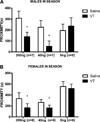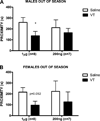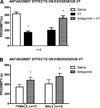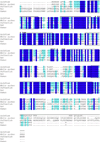Behavioral effects of hindbrain vasotocin in goldfish are seasonally variable but not sexually dimorphic
- PMID: 19616564
- PMCID: PMC3628676
- DOI: 10.1016/j.neuropharm.2009.07.018
Behavioral effects of hindbrain vasotocin in goldfish are seasonally variable but not sexually dimorphic
Abstract
We have previously demonstrated that centrally administered vasotocin (VT) inhibits social approach toward same-sex conspecifics in male and female goldfish, and that this behavioral effect is dependent upon VT projections to the hindbrain. We now show that there are no sex differences in sensitivity to the behavioral effects of VT, though differences do exist in responsiveness across seasons in both sexes. A central dose of 1 microg, but not 200 ng, inhibited social approach in goldfish in non-reproductive condition, whereas a dose as low as 40 ng inhibited social approach in fish in full reproductive condition. In males and females in full reproductive condition, social approach behavior was facilitated by central administration of 500 ng of a V(1A) specific antagonist. In addition, the behavioral effects of exogenously administered central VT were blocked by central administration of 1 microg of a V(1A) antagonist. These results demonstrate that the propensity to approach a conspecific, a simple behavior underlying many social interactions, is controlled by a V(1A)-like receptor, and that VT's behavioral effects depend on reproductive context. Quantitative real-time PCR showed that the seasonal changes in behavioral responsiveness to VT are associated with changes in the expression of a V(1A)-like receptor in the hindbrain, but not the mid- or forebrain, indicating that the seasonal regulation of social approach behavior likely depends on the local modulation of the expression of this receptor within a primitive peptide circuit in this species.
Figures






Similar articles
-
A primitive social circuit: vasotocin-substance P interactions modulate social behavior through a peripheral feedback mechanism in goldfish.Eur J Neurosci. 2008 May;27(9):2285-93. doi: 10.1111/j.1460-9568.2008.06210.x. Eur J Neurosci. 2008. PMID: 18445219
-
Vasotocin immunoreactivity in goldfish brains: characterizing primitive circuits associated with social regulation.Brain Behav Evol. 2009;73(3):153-64. doi: 10.1159/000219485. Epub 2009 May 20. Brain Behav Evol. 2009. PMID: 19468212
-
Peptide effects on social behavior: effects of vasotocin and isotocin on social approach behavior in male goldfish (Carassius auratus).Behav Neurosci. 2004 Jun;118(3):620-6. doi: 10.1037/0735-7044.118.3.620. Behav Neurosci. 2004. PMID: 15174940
-
Steroid-induced plasticity in the sexually dimorphic vasotocinergic innervation of the avian brain: behavioral implications.Brain Res Brain Res Rev. 2001 Nov;37(1-3):178-200. doi: 10.1016/s0165-0173(01)00118-7. Brain Res Brain Res Rev. 2001. PMID: 11744086 Review.
-
Implication of central neurohypophyseal hormone receptor-mediated action in timing of reproductive events: evidence from novel observations on the effect of a vasotocin analogue on singing behaviour of the canary.Regul Pept. 1993 Apr 29;45(1-2):85-9. doi: 10.1016/0167-0115(93)90187-d. Regul Pept. 1993. PMID: 8390083 Review.
Cited by
-
Pheromone exposure influences preoptic arginine vasotocin gene expression and inhibits social approach behavior in response to rivals but not potential mates.Brain Behav Evol. 2013;81(3):194-202. doi: 10.1159/000350589. Epub 2013 May 22. Brain Behav Evol. 2013. PMID: 23712040 Free PMC article.
-
Seasonal regulation of behaviour: what role do hormone receptors play?Proc Biol Sci. 2020 Jul 8;287(1930):20200722. doi: 10.1098/rspb.2020.0722. Epub 2020 Jul 8. Proc Biol Sci. 2020. PMID: 32635860 Free PMC article.
-
Reproductive roles of the vasopressin/oxytocin neuropeptide family in teleost fishes.Front Endocrinol (Lausanne). 2022 Oct 13;13:1005863. doi: 10.3389/fendo.2022.1005863. eCollection 2022. Front Endocrinol (Lausanne). 2022. PMID: 36313759 Free PMC article. Review.
-
Species, sex and individual differences in the vasotocin/vasopressin system: relationship to neurochemical signaling in the social behavior neural network.Front Neuroendocrinol. 2015 Jan;36:49-71. doi: 10.1016/j.yfrne.2014.07.001. Epub 2014 Aug 4. Front Neuroendocrinol. 2015. PMID: 25102443 Free PMC article. Review.
-
Social boldness correlates with brain gene expression in male green anoles.Horm Behav. 2021 Jul;133:105007. doi: 10.1016/j.yhbeh.2021.105007. Epub 2021 Jun 5. Horm Behav. 2021. PMID: 34102460 Free PMC article.
References
-
- Beiderbeck DI, Neumann ID, Veenema AH. Differences in intermale aggression are accompanied by opposite vasopressin release patterns within the septum in rats bred for low and high anxiety. Eur. J. Neurosci. 2007;26:3597–3605. - PubMed
-
- Bielsky IF, Hu SB, Szegda KL, Westphal H, Young LJ. Profound impairment in social recognition and reduction in anxiety-like behavior in vasopressin V1a receptor knockout mice. Neuropsychopharmacology. 2004;29:483–493. - PubMed
-
- Blanchard RJ, Griebel G, Farrokhi C, Markham C, Yang M, Blanchard DC. AVP V1b selective antagonist SSR149415 blocks aggressive behaviors in hamsters. Pharmacol. Biochem. Behav. 2005;80:189–194. - PubMed
-
- Boyd SK, Moore FL. Gonadectomy reduces the concentrations of putative receptors for arginine vasotocin in the brain of an amphibian. Brain Res. 1991;541:193–197. - PubMed
Publication types
MeSH terms
Substances
Grants and funding
LinkOut - more resources
Full Text Sources

